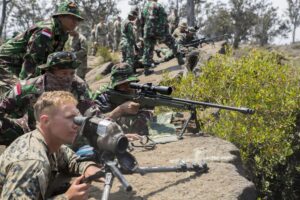Christopher Chen
COMMENTARY
 The Intergovernmental Panel on Climate Change released in August its latest report on climate change, which paints an exceptionally bleak picture of the future. Unless there are immediate, rapid and large-scale reductions in greenhouse gas emissions, global temperature will increase by 1.5 degrees Celsius or even 2 degrees Celsius within the next 20 years.
The Intergovernmental Panel on Climate Change released in August its latest report on climate change, which paints an exceptionally bleak picture of the future. Unless there are immediate, rapid and large-scale reductions in greenhouse gas emissions, global temperature will increase by 1.5 degrees Celsius or even 2 degrees Celsius within the next 20 years.The effects of climate change will span the physical environment, ecosystems and human societies. Climate change results in more frequent and extreme weather events and affects natural biological systems. According to the United Nations Development Programme’s Human Development Report 2020, the Covid-19 pandemic has demonstrated how shocks emanating from disturbances in life systems and climate change affect people and change societies. Biodiversity loss stemming from climate change can increase the risk of human exposure to both new and established zoonotic pathogens.
Indonesian and American snipers. Militaries need to collectively aim for eco-friendly systems and operations to combat climate change. The appearance of U.S. Department of Defense (DoD) visual information does not imply or constitute DoD endorsement.
Militaries as Agents of Change
It is time militaries develop more energy-efficient systems and processes, and contribute to a collective effort towards tackling climate change. Militaries are huge energy consumers and contribute significantly to climate change. But they also have emerged as an important actor in both climate change mitigation and adaptation through strategic resource planning and disaster response.
Governments are rethinking how their militaries conduct operations in the face of a deteriorating climate reality. Heat waves can render military infrastructure and hardware ineffective, while water and food shortages can drive domestic conflict and intensify interstate rivalry.
The North Atlantic Treaty Organization (NATO) noted in a recent report that it has long recognised the climate risks that its member countries face. NATO has since stepped up efforts to reduce the environmental impact of military activities and is working to build its climate resilience.
In March 2021, NATO’s foreign ministers endorsed the Climate Change and Security Agenda, which was followed by NATO’s leaders endorsing the Climate Change and Security Action Plan at their summit three months later. Commitments under the plan include significantly reducing greenhouse gas emissions arising from military activities and installations, as well as incorporating climate change considerations into defence planning, capability development, and civil preparedness and exercises.
In Asia, South Korea and Japan are bolstering military “greening” efforts by increasing the use of renewable energy. As part of their efforts to reduce their carbon footprint, both countries are setting up solar panels in their various military facilities. The threat of climate-induced risks has also featured more prominently and explicitly in their policy discussions. This year, for the first time, Japan’s defence white paper highlighted climate change as a national security issue.
As more governments acknowledge climate security risks, the pressure will be on militaries to adapt. Commitments are needed to reduce greenhouse gas emissions and implement sustainability measures in the military in national climate strategies.
Not Enough: Southeast Asia Responds Incrementally
Southeast Asia is among the most disaster-prone regions in the world. Countries in the region generally rely on the military as a first responder when disaster hits. Military spending in the region has increased substantially by 36 per cent from 2011 to 2020. The bulk of the defence budget in most of these countries goes towards routine expenditure, particularly personnel spending, operations and maintenance costs. Hence, as an important institution in the region, the military has both vested interest and responsibility to combat climate change and the ensuing security challenges.
Given that climate change and the resulting natural disasters can have significant cross-border impacts, the region would benefit from multilateral defence cooperation. The Association of Southeast Asian Nations or ASEAN Defence Ministers’ Meeting-Plus (ADMM-Plus) as a platform for multilateral defence cooperation is well placed to tackle the climate crisis by broadening its mandate. Discussions should identify innovative technological solutions to reduce the carbon footprint of militaries, plan for greener missions and operations, and incorporate climate change protocols in military operations.
The Track II Network of ASEAN Defence and Security Institutions (NADI) is an important platform for militaries to connect with strategic research institutes in the region, to find solutions for militaries to combat the climate crisis. NADI enables policy analysts in the region to discuss new ideas and formulate relevant policy recommendations regarding best practices that ADMM-Plus could adopt.
Demonstrating successful regional defence cooperation on the climate crisis will position ASEAN as a global leader. Thailand’s chairmanship of ASEAN in 2019 yielded a commitment to promote sustainable security. This focused on strengthening the capacities of ASEAN member states and provided a catalyst for defence cooperation among ASEAN countries and with the ASEAN Dialogue Partners, to address non-traditional and transnational security threats in the region. ASEAN signalled its intent to address climate security as a core security concern, yet subsequent regional efforts have failed to deliver.
Singapore’s Green Plan 2030
In Singapore, the Singapore Armed Forces (SAF) aims to reduce two-thirds of its carbon emissions by 2030 and halve its 2030 emissions by 2050. Some of its new initiatives include deploying solar panels in SAF camps and bases by 2025, replacing its current administrative vehicle fleet with an all-electric one by 2030, and introducing green aviation fuel. The SAF will also set up a sustainability office that will drive the planning and compliance of these sustainability efforts.
These initiatives are part of the efforts by the Ministry of Defence to align itself with the Singapore Green Plan 2030, a whole-of-nation movement to combat climate change and work towards halving the country’s 2030 peak greenhouse gas emissions by 2050.
Militaries have a responsibility to work with various sectors across their societies to climate-proof national security. In March 2020, Singapore’s Minister for Defence Dr Ng Eng Hen recognised that climate change is “another threat for which the SAF may not be primarily responsible but must join in the efforts [to combat] for Singapore’s security and safety.” Singapore is a small country but with a global outlook that can be a test bed and knowledge platform to trial new military innovations and working across sectors.
Collective Responsibility
There is an urgent need to combat climate change: if we do not act now, averting the catastrophe that will inevitably follow will overstretch our resources. What is clear is that climate security is a collective responsibility for all militaries and governments in the region to work together. It is no longer the sole remit of a particular line ministry as its impacts transcend sectoral siloes.
Militaries around the world have an important part to play and link with other sectors. Militaries in Southeast Asia have a long history of responding to natural hazards. It is more apparent in this region than elsewhere that failure to adapt will have detrimental consequences for all of us. If we do not treat the climate crisis as a core national security concern, we all lose.

No comments:
Post a Comment